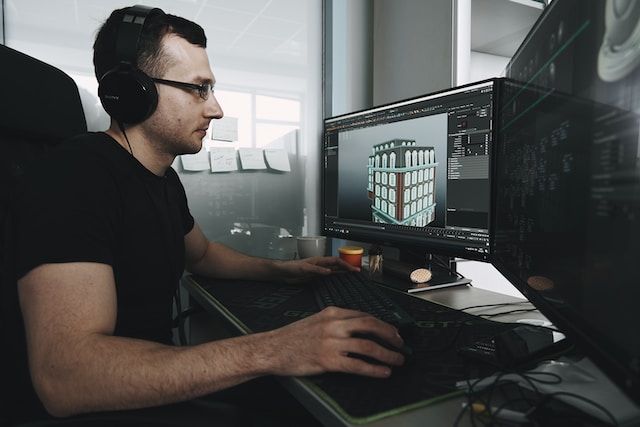3D Modeling: The Art of Virtual Crafting

Imagine walking through a fantastical, digital forest that feels so real you can almost smell the pine. Or holding a physical prototype of a gadget that, until a few moments ago, only existed in your imagination. These wonders, and countless more, are possible thanks to the magic of 3D modeling.
What is 3D Modeling?
Have you ever marveled at the breathtaking landscapes in movies or the hyper-realistic characters in video games? All that magic is the fruit of 3D modeling. Essentially, 3D modeling is the process of creating three-dimensional objects and scenes using specialized software. Imagine shaping a lump of clay into a statue, but on your computer!
History of 3D Modeling
The world didn’t have 3D models overnight. Like a tree growing its roots, 3D modeling evolved over the years. It started in the late 1960s and early 1970s when computer scientists began experimenting with creating 3D shapes on computers. Fast forward a few decades, and here we are, surrounded by 3D masterpieces.
Delving into 3D Modeling Techniques
There are various techniques to build a 3D model. Each has its strengths, and picking the right one is like choosing the perfect spice for your dish. Let’s dive into the most common ones.
Polygonal Modeling
This technique is like assembling a jigsaw puzzle, where you piece together flat shapes called polygons to create a 3D model. It’s particularly popular in video games due to its efficiency.
NURBS Modeling
NURBS stands for Non-Uniform Rational B-Splines (try saying that five times fast!). This method uses mathematical formulas to create smooth, curvy surfaces. Perfect for when you want to design something sleek and polished.
Sculpting
Imagine being Michelangelo but with a computer. Sculpting in 3D modeling is akin to molding clay into shapes.
Digital Sculpting Tools
Some popular tools for digital sculpting include ZBrush, Mudbox, and Blender. The possibilities are limitless; you’re only bound by your imagination and the processing power of your computer.
Applications of 3D Modeling
3D modeling has revolutionized the entertainment industry. From movies and video games to theme parks and advertisements, 3D models breathe life into characters, create incredible environments, and generally transport us to different worlds. Here’s how 3D modeling plays a pivotal role in various facets of entertainment:
- Movies
- Special Effects: Through 3D modeling, filmmakers create mind-blowing special effects that make dragons fly and cities crumble realistically.
- Animated Films: Animated classics like Toy Story or Shrek were made possible thanks to 3D modeling.
- Pre-visualization: Before shooting, directors use 3D models to plan scenes and determine camera angles.
- Video Games
- Characters: 3D models are used to create characters that players can control, from lifelike humans to fantastical creatures.
- Environments: From lush forests to sprawling cities, 3D modeling helps in building immersive environments in games.
- Items and Props: All the tools, weapons, and items that players can use are created using 3D modeling.
- Virtual Reality (VR)
- Immersive Experiences: 3D models are crucial in creating virtual worlds where users can interact with their environment.
- Training Simulations: VR combined with 3D modeling is used for training purposes, such as medical surgeries or flight simulations.
- Television and Commercials
- 3D Animated Shows: TV shows, especially for children, often use 3D models for characters and settings.
- Product Visualization: Advertisements often use 3D models to showcase products in the best light.
- Music Videos
- Visual Effects: Artists often incorporate 3D models in their music videos for creative visual effects.
- Animated Characters: Sometimes, music videos feature animated characters made through 3D modeling.
- Theme Parks
- Ride Design: 3D models are used in designing the rides and attractions in theme parks.
- Immersive Worlds: Entire sections of theme parks, like The Wizarding World of Harry Potter, are created using 3D modeling.
In Engineering and Architecture
Architects and engineers use 3D modeling to design buildings, vehicles, and so much more. It’s like they’re building the future right on their screens!
In Live Casinos
You know what’s even more thrilling than watching James Bond in a casino? Being in one yourself, virtually! 3D modeling brings the glitz and glamor of casinos to life online. With live casinos, you can play your favorite table games, and with the advancements in 3D modeling, the experience is incredibly immersive. Pragmatic Play https://livecasinofinder.com/vendor/pragmatic-play/, for instance, offers high-quality live casino games that transport you into the heart of the action.
Future of 3D Modeling
As we catapult into the future, 3D modeling is only going to get bigger and better. Think virtual reality, 3D printing, and maybe even holograms. Are you excited? Because we certainly are!
Conclusion
3D modeling is a versatile art form that spans across industries, from entertainment to engineering. Its evolution has been rapid, and as technology advances, the boundary of what’s possible continues to expand. So, what are you waiting for? Dive into the world of 3D modeling and become a part of the revolution!